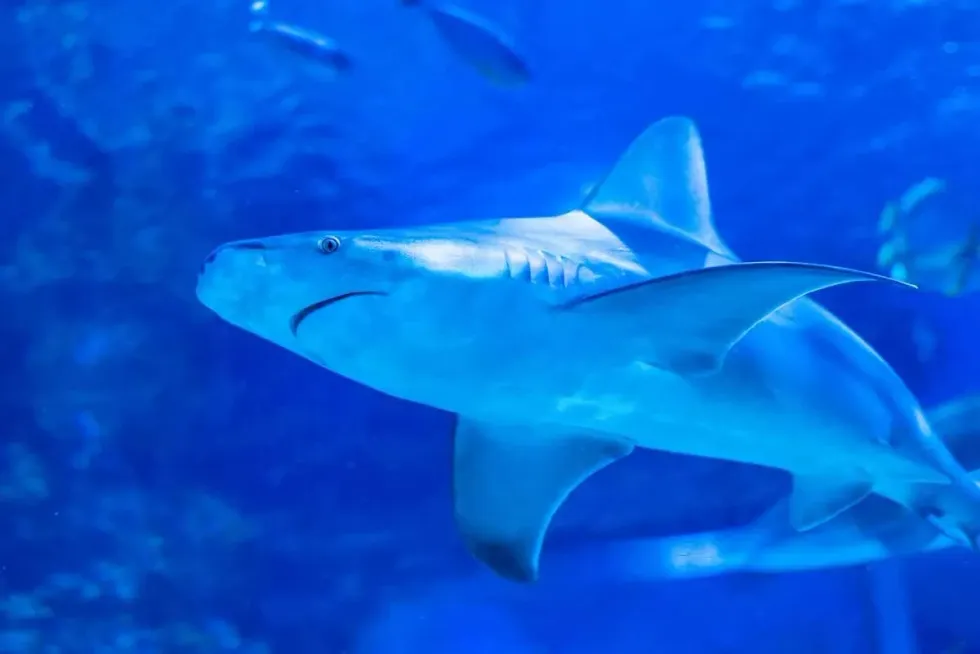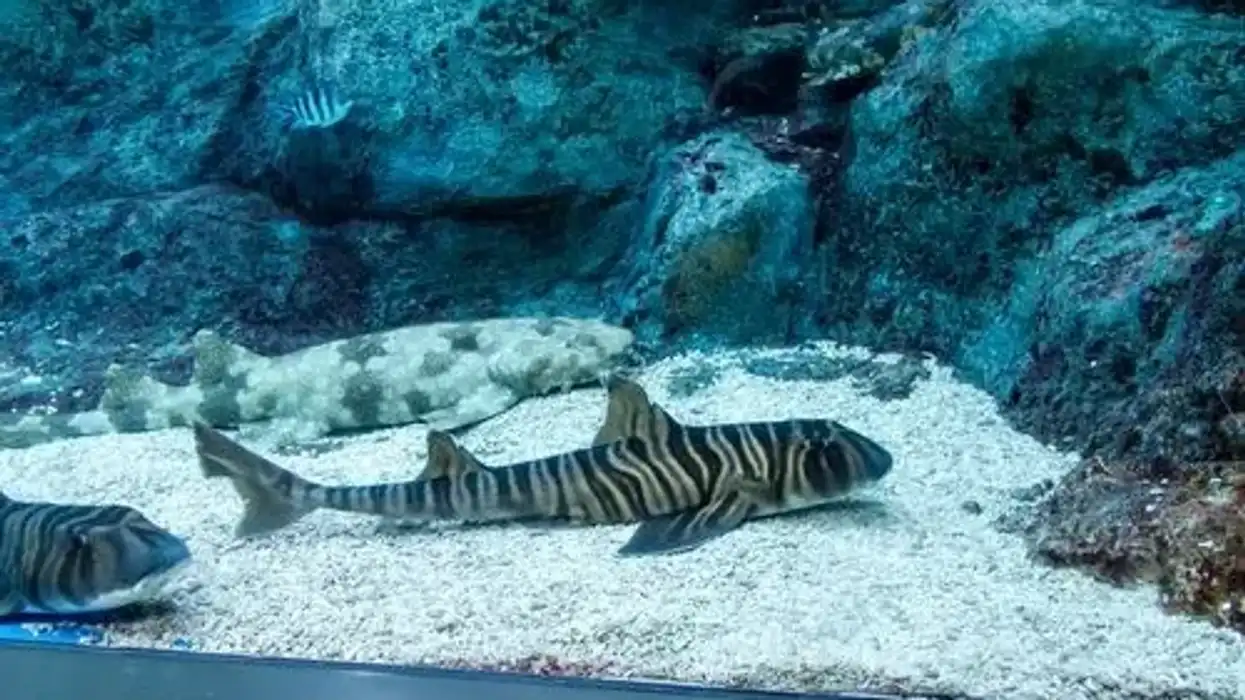Sandbar sharks (Carcharhinus plumbeus) are a large shark species generally found in temperate, tropical, and shallow coastal waters.
These species of sharks are known to be very aggressive, and dangerous and are referred to as apex predators since they are at the top of the food chain. Sandbar sharks are nocturnal animals and are generally most active at night.
These sharks are famous worldwide as they are found in almost all places across the world.
Despite this, these species of sharks are currently Vulnerable as their populations have been decreasing at a high rate due to commercial fisheries.
Found from the western Atlantic to the eastern Atlantic, the brown shark is known to travel north during the summer and migrate back south in the winter. Females are much larger and heavier than males and are known to give birth to between seven and eight pups once every three years once they become sexually mature.
If you liked reading about these facts, you could also check other facts on the basking shark and hammerhead shark.
Sandbar Shark Interesting Facts
What type of animal is a sandbar shark?
Sandbar sharks are bony fishes that can be found in coastal and temperate waters across the globe. They are found in the North Atlantic, Western Atlantic, Eastern Atlantic, and Indo-Pacific areas.
They are known to be apex predators and are placed on top of the food chain. These shark species are also more likely to be found in deeper waters.
What class of animal does a sandbar shark belong to?
Sandbar sharks (Carcharhinus plumbeus) belong to the class of fishes. They are also bony fishes. They fall under the sub-class of cartilaginous fishes and are known to be quite dangerous.
These huge shark species can be found in deeper waters. These brown sharks are comparatively larger and can be quite dangerous and dominating in the water. This brown shark belongs to the Chordata phylum.
How many sandbar sharks are there in the world?
The exact number of sandbar sharks is not known. According to the IUCN, sandbar sharks are on the IUCN red list and are currently listed as Vulnerable.
This fish species can be found in the Northern Hemisphere as well as multiple other places across the world. The population of this shark species is known to be declining due to various human reasons and activities such as commercial fishing near bays and estuaries.
Where does a sandbar shark live?
Sandbar sharks are generally found in deep, temperate, and coastal waters across the globe. This shark species is mostly found in the Northern Hemisphere, specifically Western Atlantic and North Atlantic.
These sharks are found all around the world and are quite common in places like Argentina, Brazil, the Bahamas, Mexico, and some parts of the Caribbean. Sandbar sharks can also be found in shallow coastal waters.
What is a sandbar shark's habitat?
Sandbar sharks (Carcharhinus plumbeus) are known to live in deep as well as shallow water in oceans and rivers worldwide. Brown sharks are known to be dependent on smaller fishes, squid, sharks, shrimp, and crabs for food.
They live in warm and temperate waters and are known to be one of the deadliest aquatic animals in the ocean.
Sandbar sharks are nocturnal animals and are generally awake and active during the night, which makes it quite easy for them to prey on smaller sharks and other fishes, crabs, and shrimps that are present in the ocean. They are most commonly found in the Chesapeake Bay.
Who do sandbar sharks live with?
Males are known to form schools and move together, whereas females tend to migrate alone. These species are larger sharks that are opportunistic feeders known to hunt various aquatic life like fishes, smaller sharks, squid, shrimp, and crabs. Sandbar sharks form schools and travel toward the north during the summer months and travel back south during the winter.
How long does a sandbar shark live?
This shark species has a lifespan of around 40 years in the wild. Male sandbar sharks are known to reach sexual maturity at the age of 12 years, whereas female sandbar sharks are known to reach sexual maturity at the age of 13 years.
These species reproduce once every two to three years and give birth to juvenile sandbar sharks. In captivity, these species live for about 20 years.
How do they reproduce?
These brown sharks are viviparous animals, and the embryos are planted inside the mother in the placental yolk sac. Females exhibit both biennial and triennial reproductive cycles.
The females ovulate in the summer and have a gestation period of around one year before giving birth to young pups on the nursery grounds. Each gestation period ends with around six or eight pups being born.
What is their conservation status?
The current conservation status of this species of shark, according to the IUCN, is Vulnerable, and the population of the sandbar shark is highly depleting. The population of these larger sharks is constantly decreasing because of various reasons like commercial fishing and commercial shark finning. Many other natural reasons cause the decrease in the population of sandbar sharks.
Sandbar Shark Fun Facts
What do sandbar sharks look like?
Sandbar sharks are blue-gray or brown and have both pectoral fins and dorsal fins. They have between 14 to 15 rows of sharp teeth. These sharks are very dangerous and are known as apex predators.
How cute are they?
Sandbar sharks (Carcharhinus plumbeus) can be very cute to some people. But, these sharks have rounded snouts and look very dangerous rather than cute.
This shark has a very aggressive look and sharp teeth, which makes them look like the dangerous aquatic animal that they are. Juvenile sandbar sharks are less dangerous looking. Sandbar shark babies can be considered to be very cute in appearance.
Sandbar sharks are aggressive, but they don't attack humans very much as they prefer smaller prey. This means that they are relatively safe sharks to be around unless they feel threatened.
How do they communicate?
There is limited information regarding sandbar sharks' communication and behavior. Male sandbar sharks tend to bite the females during mating to flip them upside down.
Sharks have brilliant sensors which help them to find their prey and avoid larger predators. They also have an excellent sense of smell which aids them in locating their food in shallow water. Sharks can also use their electro-sensory system to be active during the night, this is known as an ampullary electroreceptor system.
How big is a sandbar shark?
Sandbar sharks can weigh as much as 100-200 lb (50-100 kg) and can grow to be 6-8.2 ft (2-2.7 m) long. Males are shorter in length when compared to the females.
How fast can a sandbar shark swim?
Sandbar sharks are known to have an estimated swimming speed of around 30 mph (48 kph). They travel continuously for days during migration in the summer.
How much does a sandbar shark weigh?
Sandbar sharks weigh around 110-220 lb (50-100 kg) which is slightly less than bull sharks. These sharks generally prey on other fishes and smaller sharks and are known as apex predators.
Sandbar sharks are placed at the top of the food chain because of their ability to hunt other aquatic life easily. Found in deeper water, these sharks are large, and the females are known to be heavier and longer compared to males. Some sandbar sharks are recorded to weigh as much as 330 lb (150 kg).
What are the male and female names of the species?
Sandbar sharks do not have any particular names for the male and female species. These sharks are commonly known as brown sharks because of their body color, and in terms of scientific names, the sandbar shark is referred to as Carcharhinus plumbeus.
What would you call a baby sandbar shark?
Sandbar shark babies, just like other shark babies, are called pups. Sandbar sharks give birth to between six and 13 pups every two to three years. The babies of sandbar sharks are very cute in appearance, unlike their aggressive parents. Juvenile sandbar sharks attain sexual maturity at the age of 12 to 13 years, depending on their gender.
What do they eat?
Sandbar sharks are known to prey on various aquatic animals like fish, squid, shrimp, crabs, and even other small shark species. These sharks are known to be very dominating in the ocean and deep waters.
Sandbar sharks can swim at great speeds with the help of their dorsal and pectoral fins. The first dorsal fin helps them move quickly underwater.
Although these shark species are present at the top of the food chain, they are still hunted by bigger shark species such as tiger sharks and great white sharks. Humans are also known to eat sandbar sharks, but hunting and commercial fishing of sandbar sharks has now been banned due to their Vulnerable status.
Are they dangerous?
This species of shark are very dangerous and are known as an apex predator because of its ability to prey on many aquatic animals like fishes, sharks, squid, and shrimp. This shark is known to have aggressive behavior, just like bull sharks.
Sandbar sharks can even attack humans if they feel threatened, but no such event has ever been recorded. Therefore, they aren't considered to be dangerous to humans, but they are dangerous to other small fish and aquatic species.
Would they make a good pet?
Sandbar sharks are not a great choice for pets as they can be aggressive, and dangerous, and can kill tank mates. These sharks live for longer durations (about 40 years) in the wild than in captivity, so they are much better off being kept in their natural habitats.
All commercial fishing of sandbar sharks was banned by the National Marine fisheries service in 2008, as they were declared Vulnerable due to overfishing.
Did you know...
The litter size of sandbar sharks will vary in different locations across the world, including the Chesapeake Bay, and is based on the location and temperature of the place. Sandbar sharks are most commonly found in the Chesapeake Bay.
Chesapeake Bay is deemed to be unsafe for swimming because of the number of shark species present. Females have a gestation period of one year.
The rounded snout of the sandbar shark resembles the snout of a bull shark. Sandbar sharks do not hibernate during winter, but they do migrate south to be in warmer areas.
Why are sandbar sharks important to the ecosystem?
Sandbar sharks are responsible for keeping the ocean ecosystem balanced, this job falls onto them because they eat many aquatic species. In an aquatic ecosystem, there are a lot of animals and fishes.
If the sharks are not hunting, these animals could multiply rapidly and cause problems for other aquatic animals. These sharks are apex predators and are at the top of the food chain which makes them incredibly important.
Sandbar shark attacks
This species of shark is quite aggressive, and its rounded snout helps them hunt and attack various aquatic life. However, sandbar sharks have never indulged in attacks on humans, but they could cause serious damage if they do.
Here at Kidadl, we have carefully created lots of interesting family-friendly animal facts for everyone to discover! Learn more about some other fish, including Bolivian ram or black neon tetra.
You can even occupy yourself at home by drawing one of our Sandbar shark coloring pages.










